WordPress scanner is a tool to find vulnerabilities within the WordPress core, themes, and 3rd-party plugins. This software might also suggest remediation guidance or fix them automatically, but the major functionality remains vulnerability detection.
A WordPress scanner is important to regularly scan WordPress websites since it’s a prime target for cybercriminals, thanks to its user base constituting almost 40% of the entire internet. Besides, the latest research by SUCURI shows that over 95% of scanned WP sites were infected with one or more vulnerabilities.
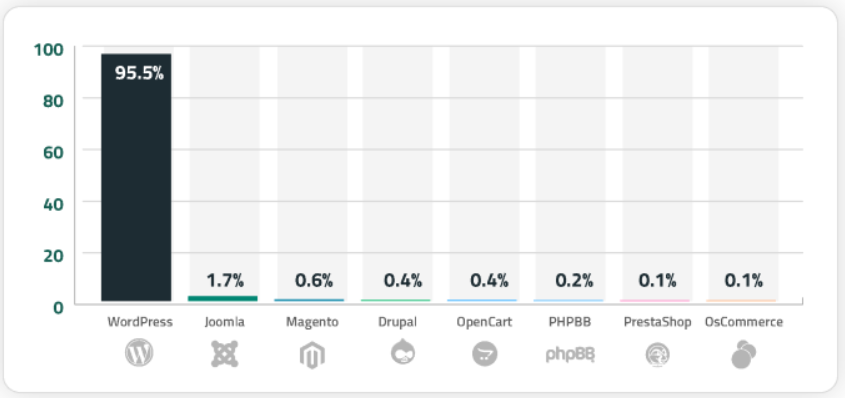
WordPress scanning becomes even more critical if a website uses many plugins, which are the root cause of over 96% of vulnerabilities [1] per Patchstack.
Geekflare has made this curated list of WordPress Scanners based on their scanning features, business applicability, and more.
- 1. Sucuri – Best for Website Security Protection
- 2. Intruder – Best for Automated Security Scanning
- 3. HackerTarget – Powered by Open Source Tools
- 4. Detectify – Best for Medium Business
- 5. WPSec – Best Open Source Vulnerability Scanner
- 6. SecurityNinja – 50+ Security Tests
- 7. Pentest Tools – Best for Small Business
- 8. Quttera – Best for Malware & Virus Scanning
- 9. Wordfence – Best All-In-One Security Plugin
- 10. Acunetix – Best for Big Business
- 11. Malcare – Best for Malware Removal
- Show less
You can trust Geekflare
Imagine the satisfaction of finding just what you needed. We understand that feeling, too, so we go to great lengths to evaluate freemium, subscribe to the premium plan if required, have a cup of coffee, and test the products to provide unbiased reviews! While we may earn affiliate commissions, our primary focus remains steadfast: delivering unbiased editorial insights, and in-depth reviews. See how we test.
1. Sucuri
Best for Website Security Protection
Sucuri is a platform-agnostic, cloud-based security tool featuring a malware and vulnerability detector, including free WordPress security scans. The free scanner needs no installation and checks for malware, domain blacklisting, outdated software, server errors, defacement, and malicious code changes or injections.

For a more in-depth assessment, Sucuri features a WordPress plugin that helps run scans directly from your WP dashboard. The paid plans offer SLA-backed malware removal by experts.
Not only this, Sucuri shields a WordPress install with its WAF from threats such as DDoS and OWASP Top 10. Paid users also get access to its content delivery network (CDN) to ensure faster distribution with minimum latency.
Sucuri Pros
Manual malware removal.
Free website scans.
WAF & CDN.
Sucuri Cons
Lacks emergency support per some G2 users.
Is expensive for small websites.
Sucuri Pricing
Here are the three introductory Sucuri plans covering in-depth website security.
| Plans | Pricing | Offerings |
|---|---|---|
| Basic | $199.99/year | Unlimited malware removal (30 hours SLA), WAF, CDN, advanced security scans (every 12 hours), and SSL support. |
| Pro | $299.99/year | Everything in Basic+ Every 6-hour security scans, 12-hour malware removal SLA, advanced SSL support. |
| Business and more. | $499.99/year | Everything in Basic+ Every 30-mins security scans, 6-hour malware removal SLA, advanced SSL support. |
2. Intruder
Best for Automated Security Scanning
Intruder is a powerful vulnerability scanner that thoroughly checks for weaknesses across your entire website and its underlying infrastructure. This includes identifying unencrypted admin services, exposed databases, web-layer security problems such as SQL injection and cross-site scripting, and other security issues.
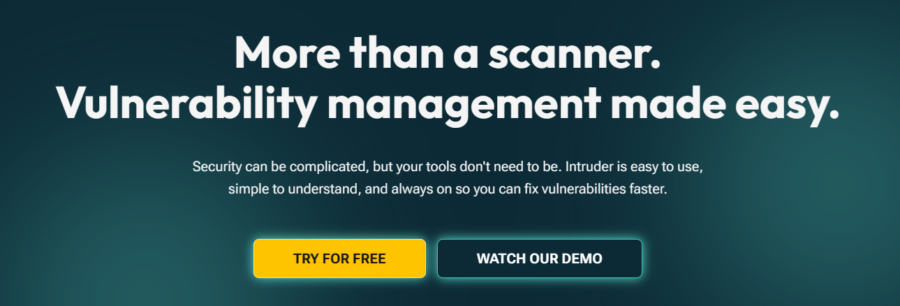
Intruder helps you keep tabs on SSL/TLS certificate expiry to maintain security and avoid traffic drops.
In addition to WordPress websites, Intruder scans servers, cloud systems, networks, and endpoint devices, including other CMS such as Drupal, Joomla, and SharePoint. It comes with multiple integrations, such as Jira, Slack, GitHub, and more, to help speed up your issue detection and remediation.
Intruder Pros
In-depth reports with excellent remediation guidance.
Good user interface.
Top-notch customer support per many G2 users
Intruder Cons
Expensive plans.
Scans can be slow.
Intruder Pricing
Check the following table to get an idea about the Intruder pricing structure for a single infrastructure target (one website).
| Plans | Pricing | Offerings |
|---|---|---|
| Essential | $79/month | External scanning, Unlimited users. |
| Pro | $169/month | Everything in Essential+ Internal agent & Network scanning, Automated cloud & emerging threats scans, Integrations, SSO. |
| Premium | Custom | Everything in Pro + Daily network scans and Premium support. |
3. HackerTarget
Powered by Open Source Tools
HackerTarget WordPress scans for the core security and server configuration, including Google site reputation, directory indexing, admin account status (enabled/disabled), hosting provider reputation, linked JavaScript & iFrames as well as vulnerable themes (2600+) & plugins (18,000+).
In addition, HackerTarget’s OpenVAS scanner performs a port scan to check for listening services and subsequently tests them for known vulnerabilities and misconfigurations. Besides, HackerTarget lets one leverage the power of Nmap WordPress NSE Scripts and Nikito web server scanners.
HackerTarget’s free site security check lets one scan 20 websites for WordPress version, Google site reputation, external links, and more.

HackerTarget Pros
Extensive themes and plugin database.
Good for bulk testing of WordPress websites.
Access to 27 scanners and OSINT tools.
HackerTarget Cons
Smaller userbase to take feedback from.
Limited to vulnerability detection with little to no remediation guidance.
HackerTarget Pricing
This section indicates HackerTarget’s Standard Plans to test up to 2000 WordPress websites.
| Plans | Pricing | Offerings |
|---|---|---|
| Starter | $10/month | Bulk WordPress Testing (500 sites), SSL testing, Standard scans (16/day). |
| Pro | $25/month | Bulk WordPress Testing (1000 sites), SSL testing, Standard scans (30/day). |
| Business | $50/month | Bulk WordPress Testing (2000 sites), SSL testing, Standard scans (100/day). |
4. Detectify
Best for Medium Business
Detectify is an enterprise-ready vulnerability scanner that tests for more than 500 vulnerabilities, including OWASP top 10, encryption & SSL misconfigurations, DNS issues, SQLi, and more.
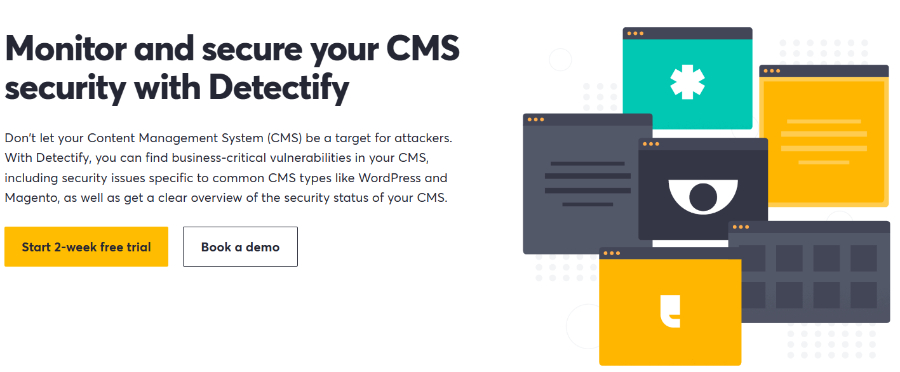
This external attack surface management (EASM) platform provides a complete view of the overall security posture, including every web asset (such as a WordPress website). One can also make custom policies to check specific changes and prioritize remediation accordingly.
Detectify will do well as a potent vulnerability scanning engine for enterprise-level, WordPress-based online businesses. However, it has plans for small attack surfaces as well.
Detectify Pros
Enterprise-worthy features such as API access & SSO.
Detailed vulnerability reports.
14-day, no-credit-card trial.
Detectify Cons
Pricey subscriptions.
Lack of WordPress-specific features.
Detectify Pricing
Detectify has subscriptions for small websites and fully-fledged, enterprise-level attack surface management, as mentioned below.
| Plan | Pricing | Offerings |
|---|---|---|
| Application Scanning | €82 /month+ | Unlimited web app scans, authenticated scanning, and personalized testing. |
| Full EASM | Quote-based | SSO, API access, 99.7% Vulnerability detection accuracy. |
5. WPSec
Best Open Source Vulnerability Scanner
WPSec uses the latest database of bugs and vulnerabilities to find issues in your WordPress websites. Its security dashboard allows adding multiple WordPress websites and tracking the details, such as outdated software, from a single interface.

WPSec supports automatic daily, weekly, or monthly scans.
WPSec sends push notifications about the pending WP core updates. It provides detailed reports with remediation steps to help understand the issues better.
WPSec Pros
WordPress-specific scanning engine.
Great for multi-site management.
WPSec Cons
Lacks addon features like a CDN.
Limited user feedback on platforms like G2.
WPSec Pricing
WPSec plans are priced based on the number of WordPress websites, type of reports, and advanced use cases like API.
| Plans | Pricing | Offerings |
|---|---|---|
| Free | FREE | 1 WordPress site, 20 scans, Automated weekly scans. |
| Premium | €29/month | Unlimited WordPress sites, Unlimited scans, Advanced reports, API & webhooks. |
| White Label | €295 /month | Unlimited scans & reports, custom domain, brand name, and logo. |
6. SecurityNinja
50+ Security Tests
SecurityNinja comes as a WordPress plugin for providing malware protection, automatic scanning, a firewall, and a lot more to safeguard websites from notorious cyber threats. The plugin is available in the official WordPress repository, and users can get started without paying anything.
Under the hood, SecurityNinja hosts a WordPress vulnerability scanner that scans the website for exploitable plugins against public repositories, such as the National Vulnerability Database (US).
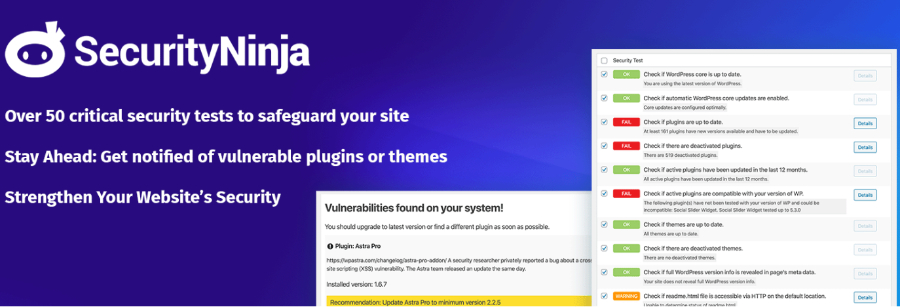
Besides, SecurityNinja lets users change the login URL and block 600+ million IPs of bots and spammers. One can also blocklist visitors from a specific country and protect the login form from brute force attacks.
SecurityNinja performs integrity checks to see if the WordPress core and plugins aren’t modified. It allows users to redirect blocked visitors and stop malicious requests. It suits someone managing a bunch of WordPress sites with its MainWP integration.
SecurityNinja Pros
Multiple WordPress-centric features, such as integrity checks & login protection.
Cloud-based firewall.
Free tier and 30-day premium trial.
SecurityNinja Cons
Lesser known brand
Free version is quite restrictive
SecurityNinja Pricing
SecurityNinja has one of the simplest pricing structures, with the subscriptions differing only in the number of target websites.
| Plans | Pricing | Offerings |
|---|---|---|
| Solo | $39.99/Year | Firewall, Malware protection, Events logger for one website. |
| Team | $99.99/Year | Firewall, Malware protection, Events logger for three websites. |
| Business | $149.99/Year | Firewall, Malware protection, Events logger for five websites. |
7. Pentest Tools
Best for Small Business
Pentest Tools WP scanner is powered by the WPScan database–a catalog of over 50,000+ WordPress core, themes, and plugin vulnerabilities.
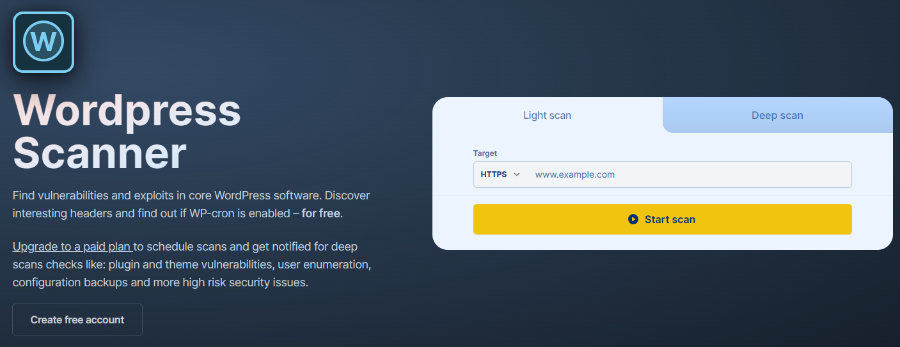
Pentest Tools performs a remote scan without needing website authentication. It simulates an attacker and checks for the WordPress version, enumerates themes, plugins, & users, and identifies vulnerabilities. It also scans for configuration backups, database exports, and timthumbs.
Pentest Tools Pros
Ease of testing and good remediation guidance
Excellent user feedback
Pentest Tools Cons
Can be expensive for individuals
Extremely restrictive free-tier
Pentest Tools Pricing
The following table sums up the three introductory Pentest Tools tiers. The top subscription (meant for bigger teams) includes premium features, such as API access and white-label reports.
| Plans | Pricing | Offerings |
|---|---|---|
| Free | $0/month | Check for WordPress core, WP-cron status, & interesting headers. |
| Basic | $85/month | Everything in Free + Deep scans checking plugin & theme vulnerabilities, User enumeration, and Scan scheduling. |
| Advanced | $190/month | Everything in Basic + Authenticated scans, Internal network scans, and Advanced reporting. |
8. Quttera
Best for Malware & Virus Scanning
Quttera Web Malware Scanner is a to check for malware, malicious iFrames, malicious code injections & ads, bad redirects, JavaScript exploits, phishing, and more. This also finds if the subject website is blacklisted by Google and others.

This one-click scanning engine is based on Quttera’s own patented malware detection technology. You can check this out at the official WordPress plugin repository for this free WordPress AI plugin
Quttera Pros
100% Free vulnerability detection.
Scan from the WP dashboard itself.
Quttera Cons
Too many false positives as per user reviews.
Scans can get stuck sometimes.
Quttera Pricing
Quttera’s free plan is limited to vulnerability detection and blacklist checking. For anything else, one must subscribe to one of the mentioned plans.
| Plans | Pricing | Offerings |
|---|---|---|
| Essential | $10/month | Service side malware scans, WAF, DDoS protection, and External scans. |
| Premium | $179/year | Everything in Essential + Automated & manual malware removal, and Blacklist removal. |
| Emergency | $249/year | Everything in Premium + Faster response time & Frequent scans. |
9. Wordfence
Best All-In-One Security Plugin
Wordfence covers vulnerable themes, plugins, WordPress core, login security, intrusion protection, file change detection, and a lot more to provide a 360-degree security envelope for WordPress sites.
With Wordfence one gets a malware scanner, firewall, IP filtering (including country-based blocking), scheduled scans, manual malware removal, and more.

One can download Wordfence from the WordPress plugin directory and start with the free tier. The paid subscriptions are even more feature-rich, with the major differentiator being malware removal and premium support.
Wordfence Pros
WordPress-centric vulnerability detection.
Location-based IP blocking.
Additional features like 2FA & reCAPTCHA.
Powerful free version covering vulnerability detection and login protection.
Wordfence Cons
G2 users flag poor customer support.
Even the introductory paid tier lacks malware removal.
Wordfence Pricing
Wordfence has a robust free tier covering malware scanners, firewalls, vulnerability detection, file change checks, and login protection. Paid plans are obviously superior, with the highlight feature being tech support.
| Plans | Pricing | Offerings |
|---|---|---|
| Premium | $119/year | Scheduled scans, Vulnerability scanner, Login security, Unlimited scans, and IP blocking. |
| Care | $490/year | Scheduled scans, Vulnerability scanners, Login Security, Unlimited scans, and IP blocking. |
| Pro | $950/year | Everything in Care+24/7 Support with one-Hour response time. |
10. Acunetix
Best for Big Business
Acunetix by Invicti is a web application security scanner that supports various tech stacks, including WordPress.
It checks for multiple WordPress-specific vulnerabilities, as listed below.
- Outdated WordPress core, plugins, and themes.
- Malware-affected themes and plugins
- Brute force attacks (weak passwords & XML-RPC)
- Publicly available wp-config.php files
- User enumeration

The best part about Acunetix is its expendability to other CMS (including custom-built applications) and ability to cover a wide range of vulnerabilities, such as OWASP 10, SQLi, XSS, misconfigurations, and more.
Acunetix Pros
Extensive vulnerability coverage.
G2 users praise its ease of use.
Acunetix Cons
Lack of upfront, WordPress-specific plans.
G2 users encountered licensing issues, such as the inability to add new URLs.
Acunetix Pricing
For information on Acunetix pricing, users would need to contact their team, as it is quote-based pricing.
11. Malcare
Best for Malware Removal
Malcare is one of the best web security solutions exclusively dedicated to WordPress. They cover various fronts to make WordPress websites safe and performant, including a firewall, login protection, vulnerability monitoring, uptime monitoring, and malware removal.
In fact, it was highly successful in removing malware when testing for our MalCare review. Plus, it has a lightweight operation that didn’t impede your other workflows!
It also blocks bots to avoid a website’s content getting scraped. Moreover, Malcare checks for Google blacklisting and helps remove malware with just a click.

A few more features that make Malcare a wholesome WordPress package include performance monitoring, 1-click staging & migrations, incremental backups, activity logs, etc.
Malcare Pros
Goes beyond web security with features, including staging, migration, etc.
Powerful free tier with firewall, login security, & more
Malcare Cons
Lack of monthly subscriptions.
No free trial of premium plans.
Malcare Pricing
Malcare subcription are based on the features, irrespective of the number of sites (one, three, or ten). The free tier provides WAF, Login security, vulnerability scans and monitoring, uptime monitoring and centralized updates. Paid users get more in the form of malware removal, automated updates, backups, staging, etc.
| Plans | Pricing | Offerings |
|---|---|---|
| Plus | $149/yr | Firewall, Vulnerability & uptime monitoring, Centralized updates, Bot protection, Backups, Staging, and Migration. |
| Pro | $299/yr | Everything in Plus + Greater frequency for uptime checks, Backups, and Scans. |
| Max | $499/yr | Everything in Pro + Hourly malware scans, Hourly backups. |
Best WordPress Vulnerability Scanners Comparison
The table below compares the best WordPress vulnerability scanners based on their coverage, standout features, and free tier or trial.
| Vulnerability Scanner | Coverage | Standout Feature(s) | Free Tier/Trial |
|---|---|---|---|
| Sucuri | Malware, OWASP 10, DDoS, Outdated software, Server errors, Code injections | CDN, WAF | ❌ |
| Intruder | Unencrypted admin services, Exposed databases, SQLi, XSS, SSL/TLS issues | Detailed remediation steps | 14-Day Free Trial |
| HackerTarget | Plugins, Themes, JavaScript, iFrames, Directory indexing | Bulk WordPress testing, 27 Vulnerability scanners | ❌ |
| Detectify | OWASP 10, SQLi, DNS & SLS/TLS issues, Misconfigurations | Deatiled vulnerability reports | 14-Day Free Trial |
| WPSec | WordPress core, Themes, & Plugins | Unlimited scan locations | Free Tier |
| SecurityNinja | Malware, Bad IPs, WordPress core, Plugins, & Themes | Firewall, Geo-blocking | Free Tier & Premium Trial |
| Pentest Tools | WordPress core, Themes, Plugins, Configuration backups, Database exports, User enumeration, and TimThumbs | Testing automation | Free Tier |
| Quttera | Malware, iFrames, Code injections & ads, Bad redirects, JavaScript | Free Vulnerability Detection | Free Tier |
| Wordfence | WordPress core, Themes, Plugins, Files, Malware | Geo-blocking, 2FA, reCAPTCHA | Free Tier |
| Acunetix | WordPress code, Plugins, Core, User enumeration, Malware, OWASP 10, SQLi, XSS, Misconfigurations | Extensive vulnerability coverage | ❌ |
| Malcare | Malware, WordPress core, Themes, Plugins, Bots | Staging, Backups, Firewall | Free tier |
Benefits of Wordpress Vulnerabilities Scanner
There are 3 prime benefits of having a WordPress vulnerability scanner, such as improved security, compliance, etc., as listed below.
- Proactive Security: Hacks & data breaches are costly to remediate and sometimes result in a business closure. Consequently, it’s better to be proactive about web security and perform regular scans to identify issues upfront.
- Regulatory Compliance: Based on the industry and location, a website might be required to regularly scan and document security issues for reporting later, as well as perform advanced scans.
- Avoid Blocklisting: Malware scans and removals help websites evade blocklists and maintain their brand reputation. Besides, blocklisted websites often suffer from search engine penalties (meaning lesser visibility), ad network bans, lower email deliverability, etc., which result in revenue loss.
How to Choose Best Wordpress Vulnerabilities Scanners?
Vulnerabilities scanners are vital to keep a tab on suspicious activity. To choose a comprehensive vulnerability scanner for your WordPress project, there are 8 factors to consider, such as compatibility, scanning bandwidth, integrations, and more, as explained below.
- Compatibility: There are multiple security scanners in the market, and it’s vital to ensure their WordPress compatibility upfront. Besides, it’s important to check if the scanner works alongside the existing set of plugins and themes.
- Scanning Bandwidth: Protection from internet threats like OWASP 10, SQLi, XSS, malware, DDoS, and brute-force attacks are nice to haves. Plus, having an in-built PHP security checker is essential since it makes for WordPress core, themes, and plugins.
- Integrations: How about running a WordPress scan from Slack and getting the results right there? Integrations give you such luxuries. Therefore, it’s efficient to have integrations with tools you might already be using.
- Performance: Though running WordPress scans without consuming your own resources isn’t possible, it’s desirable to have minimum impact on live performance. Besides, the scanner should produce a minimum number of false positives to avoid resource wastage.
- Extra Features: In addition to vulnerability detection, it’s vital to have a web application firewall (WAF) to filter incoming traffic to keep cyberattacks and potential threats at bay. Moreover, scheduled scans, detailed reports with remediation guidance, malware removal, downtime alerts, etc., are some good features one should look for.
- Support: The scanner’s primary job is vulnerability detection, but sometimes, it can be malware that can take the site down or deface it. In such emergency situations, if you don’t have a dedicated cybersecurity team, it’s better to opt for a vulnerability scanner with 24/7 tech support.
- Reputation: As a secondary check, take the user feedback at forums like G2, Reddit, Quora, and Trustpilot seriously. While all companies strive to make their product competitive, it’s better to know potential drawbacks that can cost you dearly.
- Pricing: Cost is a no-brainer for anything we purchase, including a vulnerability scanner. But sometimes companies play smart and don’t offer a trial or free tier to check things before paying, citing various reasons. I would advise you to steer clear and first opt for brands that let you test ride without payment. Among other things, this is important to gauge if the tool is easy enough to use for your level of technical expertise.
Best Practices for WordPress Security
Securing a WordPress website involves a multifaceted approach consisting of these 13 best practices that comprise updates, strong passwords, scans, firewalls, and more, as explained subsequently.
- Regular Updates: Outdated software (core, plugins, and themes) are the biggest risk-making elements for any WordPress website. Therefore, it’s a good practice to turn on automatic updates or manually update everything at the earliest.
- Strong Passwords & User Management: Admins should use strong passwords–a combination of uppercase & lowercase letters, numbers, and special characters. Likewise, enforce strong password policies (with plugins like SolidWP) with two-factor authentication enabled for all users.
- Two-factor authentication (2FA): This comes into play when passwords get compromised. It asks for a code sent to the registered mobile number or email in addition to the passwords as a second line of defense. There are many plugins to implement this, but I have personal experience with mini Orange [2], which offers a lifetime free tier for up to three users.
- Vulnerability Scans: As an advanced measure, having a vulnerability scanner checks issues with the website, especially 3rd-party themes and plugins–the prime targets of cybercriminals.
- Web Application Firewall (WAF): A firewall adds another layer to the security equation by sitting in front of the origin server and shielding it from threats such as XSS, SQLi, DDoS, and more. WAFs filter every incoming HTTP request and are generally platform-agnostic. These firewalls also help in blocking IP based traffic.
- Backups: Despite every security measure, hacks and breaches can happen, and it’s advised to take backups as a last resort in emergency situations. Though most web hosts offer backup in their subscriptions, make sure they aren’t being stored on the same server. Additionally, one can easily store copies of their website themselves using FTP tools like Filezilla.
- Reputable Hosting: Web hosts offering rock-bottom price points are attractive for obvious reasons. However, this lesser cost might reflect in a lackluster security posture and performance throttle. So, try to opt for good web hosts like Kinsta for WordPress-centric security and superior performance.
- File Permissions: Set appropriate read, write, and execute permission for your files. These permissions are expressed as three-digit numbers, such as XYZ, assigned for the users, group, and others, respectively. Check the official WordPress file permissions [3] doc for more information.
- Login Security: Plugins like Limit Login Attempts Reloaded [4] can help restrict failed logins after a certain number of trials. This ensures protection against brute force attacks. Another noteworthy practice is changing the default WP admin URL (domainname.com/wp-admin) to something else.
- Monitor Logs: Logs are important to check user activity, detect ongoing attacks, and provide an audit trail for regulatory compliance. It can also help you identify if your vulnerability scanner plugin actually works or simply sits idle under the guise of an active scan.
- Incident Response Plan: It’s good to have detailed guidelines in advance covering various security incidents, such as a data breach, defacement, or lockouts. The plans should contain detailed steps for attack identification & containment, eradication, and post-attack recovery.
- Minimize Plugins: More plugins simply means more attack surface. Therefore, try to find plugins offering multiple features to limit the overall number.
- Secure Development: Security should not be an afterthought, and one should integrate vulnerability scanners and penetration testing tools into their SDLCs to catch issues as early as possible.
Final Thoughts
As websites become more dynamic and interactive, the number of WordPress plugins will only rise. This holds especially true for businesses lacking an in-house WordPress developer who can add functionality without adding yet another plugin. Consequently, website security scanners are unavoidable.
Most WordPress scanners have a free trial or free version one can test before paying. Plus, some even offer manual malware removal like SUCURI–a critically important feature for small websites not have a cybersecurity team of their own.
Moreover, WordPress debugging tools are something you should look at for developer-centric, in-depth troubleshooting.
References
1. Infected Websites Platform Distribution as per SUCURI
2. Mini Orange WordPress Plugin

